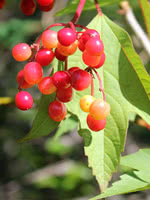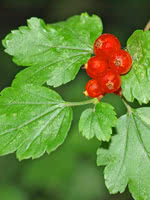Mon-Fri 9am - 5pm Mountain time
Highbush Cranberry vs Alpine Currant
Viburnum opulus var. americanum (trilobum)
Ribes alpinum
NOT AVAILABLE THIS SEASON - MIGHT RETURN
Highbush Cranberry produces attractive white flowers in late June and bears edible fruit that matures to a bright red colour in the late summer.
This shrub, native to much of Canada, is fast growing, and its fruit can be eaten raw or cooked into a sauce.
Alpine Currant is a great shrub to plant along sidewalks, near building or at your property boundary as a hedge or accent species. It is widely used by commercial landscapers in parking lots and near buildings because of its hardiness, attractiveness, and pollution tolerance.
While Alpine Currant produces edible berries, they are not palatable.
Highbush Cranberry Quick Facts
Alpine Currant Quick Facts
In row spacing: 0.6 m (2.0 ft)

